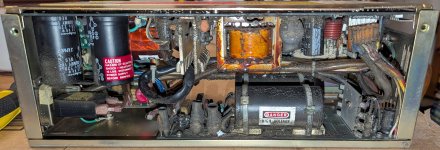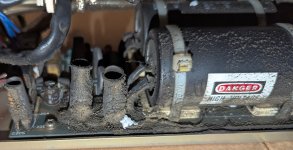Hi everyone! I am sorry for the long delay, but figured I would give a status update on my restoration of my MicroPDP-11/73, after all of your super helpful tips and pointers.
I am not sure what the black "gunk" was that was all over the inside, and in retrospect trying to clean it out with IPA and swabs was not the greatest idea. I liked the idea of a compressor, but due to lack of space, I ended up buying an electric (plug-in) blower -- a small hand-hold 90CFM pretty powerful thing. The blower blasted most of the gunk out of the way.
I ended up separating the three boards in the power-supply (H7864A), replacing the three RIFA capacitors, some of which had visible cracks in the plastic casing. I ended up tracing out and drawing the schematics for the ac/dc PCB with the large caps. Happy to share if anyone is interested?
It took a bit of time to get my hands on SL-156 connectors, pins and a working crimping tool, to make a myriad of connectors (i.e. AC/DC converter PCB to banana plugs; power connector from the switching PCB to adequate sized bundled up thick-gauge wire coming out of the PSU to end in 10 AWG wires to lugs to be connected to load resistors).
I then proceeded with reconditioning the caps using a variable AC power supply (0-140V ac / 2A) with the switching PCB disconnected, with a relatively small load resistor (300ohm/200W) connected serially with an incandescent light bulb across the 250V DC output of the PCB, going in steps by increasing the AC input by ~20V increments at a time, every 20-40 minutes or so. Once I was running at line power (110V), I let it soak for 8-10 hours, drawing around ~320mA.
Once I finished with the AC/DC converter PCB, I reconnected the switching PCB, and added modest loads to all the DC rails, while I again started from 0V ac input, and increasing the input voltage in steps all over. The switching PCB is doing some interesting things when not fed full line input. Not exceeding any output voltage, but sometimes providing lower-than rated output voltages, and sometimes dropping to 0V. I figured it would still exercise the caps on the switching PCB, even if switching didn't start, so I went slow, and eventually reach full mains input voltage. Switching started at some point around 70-80% of full input voltage, and the output voltages became much more consistent above that. Once I reached 110V, I again let the PSU "soak" for a longer while, still using fairly modest loads.
I then proceeded to put the PSU back together, and install the fans (but otherwise an empty BA23 enclosure). I then progressively started out, running at full input voltage, and progressively increase the load on all the DC rails. I started out with 100-300 ohm With 100W load resistors. I ran each load for 20-40 minutes, then progressively decreased the load resistance. I took down some notes when I reached more significant loads:
With a 2.5 ohm/300W load resistor on the 5V rail, it draw 2A. Voltage = 5.1V, Both fans running. POK and DC OK both high. Draw 0.7A from mains.
With a ~0.7 ohm/300W load resistor on the 5V rail, it draw 7.0A. Voltage = 4.97V, Both fans running. POK and DC OK both high. Draw 1.0A from mains.
With a ~0.5 ohm/300W load resistor on the 5V rail, it draw 10.3A. Voltage = 4.883V. Both fans running. POK and DC OK both high. Draw 1.3A from mains.
With a ~0.2 ohm/300W load resistor on the 5V rail, it draw 20.5A. Voltage = 4.610V. Both fans running. POK and DC OK both high. Draw 1.9A from mains.
At this point I was a bit concerned about the voltage drop on the 5V rail, and tried to figure out what was going on. I realized that I had spliced all 5V connectors into a single 16 (or perhaps 14) AWG wire which had enough resistance at these higher loads to cause the voltage drop. I replaced cable in my test connector with a 10 AWG, and continued with the last load:
With ~0.15 ohm/600W (parallel) load resistors on the 5V rail, it draw 33.1A. Voltage = 4.988V. Both fan running. POK and DC OK both high. Draw 2.8A from mains.
This output voltage on the +5V rail made me a lot more comfortable!
I let it "soak" drawing 33.1A for a good a good while (many hours). This is close to the max. current draw on the +5V rail. The air from the fans would become pretty warm. The PSU itself became warm, but not alarmingly so.
After successfully running the PSU for a long good while, I resinstalled all the boards, the harddisk, the RX50 floppy, and connected up a laptop running tio, Speed set to 9600bps, and powered it on!
AMAZINGLY, it powered on, performed the usual memory self test, and stopped at the prompt (as I had set it to do). I checked the memory map, the device list. The harddrive had spun up as well, so it seemed there was more life in the PDP than I could ever have hoped for! On a whim, I tried to boot from the harddrive, not having much hope that it would actually work, or that the hard-drive, if working, would actually have any useful OS on it to boot; but to my surprise it proceeded booting up an old version of RSX-11M!!!!!!!
It is a bit of a weird system though. The RSX installation is pretty stripped down, and it's running a bunch of weird AT&T device drivers and random tasks. Inspecting some of the *.cmd files, gives me the impression that the PDP was used to monitor or control some aspect of some kind of printing plant. Not sure exactly what, but I dumped the harddrive overnight via dump, to preserve it.
Once I ensure that the current system is copied off correctly, I will get XXDP+ on it, and run all the 11/73 tests I can find, before I proceed to reformat the hard-drive and install a new copy of rsx!
I am still amazed that the entire PDP in it's entirety, including the hard-drive is working perfectly fine. Granted I have not yet tested the RX50 floppy. I am on the look-out for an old floppy controller to format some old DD floppies to try with, but I am not in a rush.
Throughout the process of cleaning the PDP, replacing the RIFA caps, and reconditon the other caps, I took a pretty large number of photos (~400) to document everything, including cables, connectors, pin-outs, PCB traces and components markings to keep as a record for putting it back together and in an attempt at trying to reverse-engineer parts of the PSU. I am happy to share any of those photos if there is interest?
A huge thank you to all of you for your helpful comments and helpful tips on how to go about and doing a PSU restoration!
/Jörgen



